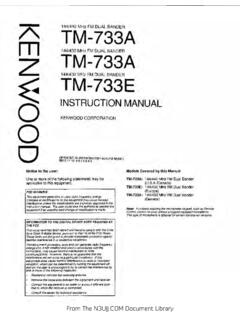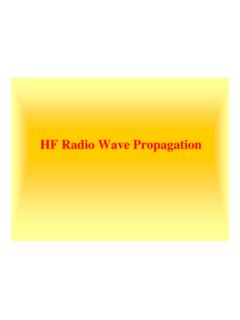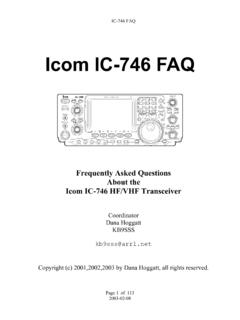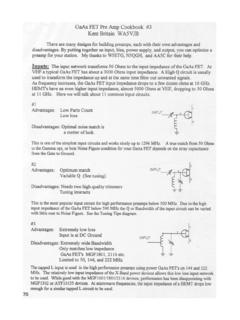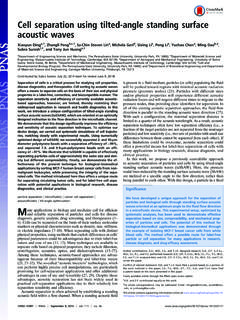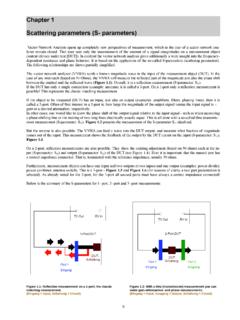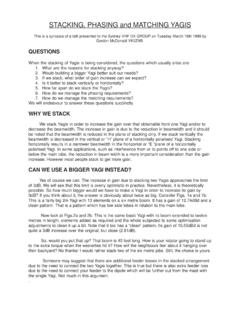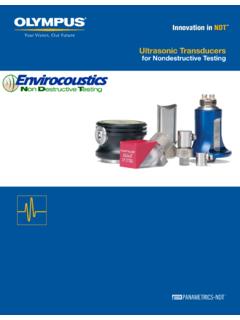Transcription of Basic Wire Antennas - Website of Amateur Radio Operator …
1 Basic wire AntennasPart I: DipolesDipole Fundamentals A dipole is antennacomposed of a singleradiating element splitinto two sections, notnecessarily of equalnecessarily of equallength. The RF power is fed intothe split. The radiators do nothave to be Characteristics Electrical length - the overall length of the dipole inwavelengthsat the frequency of interest. Directivity - the ratio of the maximum radiation of anantenna to the maximum radiation of a referenceantenna. It is often measured in dBi, dB above anisotropic (non-directional) (non-directional) radiator. Self impedance - the impedance at the antenna s feedpoint (not the feed point in the shack). Radiation Resistance - a fictitious resistance thatrepresents power flowing out of the antenna Radiation Pattern - the intensity of the radiated RF asa function of Short Dipole The length is less than /2. The self impedance isgenerally capacitive. The radiation resistance isquite small and ohmic lossesare highquite small and ohmic lossesare high SWR bandwidth is quitesmall, ~ 2% of designfrequency.
2 Directivity is ~ pattern resemblesfigure 8 The Short Dipole For dipoles longer than /5,the antenna can be matchedto coax by using loading coils For best results, the coils areplaced in the middle of eachleg of the dipoleleg of the dipole Loading coils can introduceadditional loss of 1 dB ormore For dipoles longer than /3the antenna can be matchedto coax by using linearloadingDesign Table: Short DipoleBANDLENGTH OF antenna (# 14 copper wire )INDUCTANCE OF THELOADING COIL ( H) 160 ( MHz)133 ft 10 ( MHz)67 ft 2 ( MHz)62 ft 0 ( MHz)34 ft 0 /4 dipole with inductive loadingBANDLENGTH A(# 14 wire )LENGTH B(# 14 wire )LENGTH C(# 14 wire )WIRESPACING)80( MHz)32 ft 3 in16 ft 1 in32 ft 5 in75( MHz)30 ft 1 in15 ft 1 in30 ft 2 inDesign Height: 60 ft. Feed point impedance : 40 dipole with linear loadingThe Half Wave ( /2) Dipole Length is approximately /2 ( for wiredipoles) Self impedance is 40-70 Self impedance is 40-70ohms with no reactivecomponent (good matchto coax) Directivity ~ dBi SWR Bandwidth is ~ 5%of design frequencyHarmonic Operation of /2 Dipoles A /2 dipole is also resonant at integral multiples of itsresonant frequency.
3 The self impedance of a /2 dipole at odd multiples ofthe resonant frequency is 100-150 resonant frequency is 100-150 ohms. The self impedance at even multiples is > 1000 ohms The directivity is never greater than the extendeddouble Zepp. The pattern is very complex, with many side Table: Half Wave DipoleBANDLENGTH (# 14 copper wire )160 ( MHz)255 ft 9 in80( MHz)123 ft 2 in40( MHz)65 ft 11 in40( MHz)65 ft 11 in3046 ft 3 in2033 ft 0 in1725 ft 10 in1522 ft 1 in1218 ft 9 in10 ( MHz)16 ft 6 inThe Full Wave Dipole (Double Zepp) Length is approximately ( for wire dipoles) Self impedance is ~ 6000ohms. antenna can be matched antenna can be matchedto coax with a 450 ohmseries matching section Directivity ~ dBi SWR Bandwidth ~ 5%of design frequencyDesign Table: Double ZeppBANDLENGTH OF antenna (# 14 copper wire )LENGTH OF MATCHINGSECTION (450 LINE VF = )160 ( MHz)531 ft 8 in120 ft 3 in80( MHz)256 ft 1 in57 ft 11 in40( MHz)137 ft 1 in31 ft 0 in40( MHz)137 ft 1 in31 ft 0 in3096 ft 1 in21 ft 9 in2068 ft 8 in15 ft 6 in1753 ft 9 in12 ft 2 in1545 ft 10 in10 ft 4 in1239 ft 0 in8 ft 10 in10 ( MHz)34 ft 3 in7 ft 9 inThe Extended Double Zepp Length is Self impedance is -j800 ohms antenna can be matched to antenna can be matched to50 ohm coax with a seriesmatching section Directivity ~ dBi.
4 Thisis the maximum broadsidedirectivity for a center-fedwire antennaDesign Table: Extended Double ZeppBANDLENGTH OF antenna (# 14 copper wire )LENGTH OF MATCHINGSECTION (450 LINE VF = )160 ( MHz)677 ft 7 in83 ft 7 in80( MHz)326 ft 4 in40 ft 3 in40( MHz)174 ft 8 in21 ft 7 in40( MHz)174 ft 8 in21 ft 7 in30122 ft 6 in15 ft 1 in2087 ft 6 in10 ft 10 in1768 ft 6 in8 ft 6 in1558 ft 5 in7 ft 2 in1249 ft 8 in6 ft 2 in10 ( MHz)43 ft 8 in5 ft 5 inThe 3 /2 Dipole Length is Self impedance ~ 110 ohms antenna can be matched to50 ohm coax with quarterwave 75 ohm matching50 ohm coax with quarterwave 75 ohm matchingsection Directivity ~ dBi. Directions of max radiationpoint to all areas of interestfor HF DX when antennawire runs E-WDesign Table: 3 /2 DipoleBANDLENGTH OF antenna (# 14 copper wire )LENGTH OF MATCHINGSECTION (RG11 Z=75 VF = )160 ( MHz)797 ft 10 in88 ft 9 in80( MHz)384 ft 3 in42 ft 9 in40( MHz)205 ft 8 in22 ft 11 in40( MHz)205 ft 8 in22 ft 11 in30144 ft 2 in16 ft 0 in20103 ft 0 in11 ft 6 in1780 ft 8 in9 ft 0 in1568 ft 9 in7 ft 8 in1258 ft 6 in6 ft 6 in10 ( MHz)51 ft 5 in5 ft 9 inDual Band Dipole It is possible to select thelength of a dipole and itsseries matching section suchthat low SWR can be obtainedon two bands The SWR bandwidth of this The SWR bandwidth of thistype of dipole is less than aregular dipole.
5 Full bandcoverage is not possible onmost HF bands Note: the dipole alone isgenerally not resonant oneither bandDesign Table: Dual Band DipoleBAND PAIRLENGTH OF antenna (L) (# 14 copper wire )LENGTH OF MATCHINGSECTION (X) (Z=450 VF = )20m / 15m51 ft 0 in50 ft 8 in17m / 12m28 ft 7 in46 ft 8 in17m / 12m28 ft 7 in46 ft 8 in10m / 6m16 ft 6 in31 ft 5 in75m / 40m144 ft 10 in89 ft 6 in30m / 17m54 ft 9 in36 ft 2 in15m / 10m38 ft 8 in53 ft 4 inOff-Center Fed Dipole (OCD) By moving the feed pointaway from the center, it ispossible to have a low feedpoint impedance atfrequencies other than thefrequencies other than theodd multiples of theresonant frequency The feed point impedanceof an OCD is > 100 ohms,necessitating use of atransformer at the feedpoint The relationship between feedposition and feed impedance isvery complex, but in general asthe feed moves towards awayfrom the center, the impedanceincreases and the number ofharmonics with low impedanceresonance Table.
6 OCD antennasBANDS OFOPERATIONLENGTH OFSHORT LEG (La)LENGTH OFLONG LEG (Lb)NOTES40/20/15/1012 ft 0 in57ft 0 in# 14 Cu wire ; use 4:1 Balun80/40/20/15/1023 ft 6 in111 ft 6 in2, #14 Cu wires spaced80/40/20/15/1023 ft 6 in111 ft 6 in2, #14 Cu wires spaced8 in; use 4:1 Balunand a choke balun onthe coaxUse of a dipole on several bands It is possible to use a center fed dipole over a widerange of frequencies by: feeding it with low-loss transmission line (ladder line) providing impedance matching at the transceiver The lower frequency limit is set by the capability of thematching network. Typically a dipole can be used downmatching network. Typically a dipole can be used downto 1/2 of its resonant frequency. The radiation pattern becomes very complex at higherfrequencies. Most of the radiation is in two conicalregions centered on each wire There is no special length, since the antenna will not beresonantThe G5RV: what is it, really? The G5RV was originally designed as a 3 /2 antennafor use on 20 meters.
7 It was used as a multi-band antenna because when fedwith ladder line (not coax!) it is easy to match the onany band from 80m to 10m A G5RV used as a multi-band antenna should be fed A G5RV used as a multi-band antenna should be fedwith ladder line. Most commercially-made G5 RVantennas are lossy because they are fed with coax. There is no special length for a G5RV; it only needs tobe at least /4 long at the lowest operating frequency. There is nothing magic about a G5RV. It is just adipoleDipole Polarization On the HF bands dipoles arealmost always horizontallypolarized. It is not possible toget a low angle of radiationwith a vertical dipole(electrically) close to the(electrically) close to theearth Reflection losses are alsogreater for verticallypolarized RF The height of the supportrequired for a vertical dipolecan also be a problemPutting up a Dipole A dipole may be erectedbetween 2 supports orwith one support. A dipole antenna using a A dipole antenna using asingle support is known asan inverted-V The legs of a dipole mayalso be bent to form aninverted U.
8 The bendshould be at least half wayto the end of the wireDipole antenna Materials wire #14 Copperweld very strong kinks very easily; it is difficult to work with does not stretch subject to corrosion #14 stranded copper wire with vinyl insulation #14 stranded copper wire with vinyl insulation moderately strong easy to work with, does not kink can stretch under high tension (a problem with long Antennas ) does not corrode Monel trolling wire strong much higher resitivity than copper corrosion resistantDipole antenna Materials Insulators ceramic strong resist very high voltages not affected by sunlight expensive plastic weaker than ceramic insulators resist moderately high voltages can be degraded by sunlight relatively inexpensiveDipole antenna Materials Baluns choke balun (several turns of coax wound into coil ~ 6 in india) is usually sufficient unless impedance transformation isrequired Powdered-iron core baluns should be used within their ratingsto avoid core avoid core saturation.
9 Support ropes should be at least 3/16 inch diameter and UV stabilized UV stabilized Dacron works well in most applications polyolefin ropes quickly degrade in sunlight and should beavoidedDipole antenna Supports Almost any structure can be used to support a dipole The antenna should be kept at least 12 inches awayfrom a conducting support. If trees are used, leave some slack in the antenna sothat swaying of the branches does not snap the wirethat swaying of the branches does not snap the wire The support should be tall enough that the dipole is atleast 1/2 wavelength about the surrounding terrain( /2 =492/f)Other useful information Do not run a dipole above power lines!!!! When the feed line leaves the dipole, it should runperpendicular to the dipole for at least 1/4 wavelength Avoid running the dipole parallel to long conductingobjects such as aluminum gutters. The antenna cancouple to the other metal and be detunedcouple to the other metal and be detuned When erecting a dipole as an inverted-V, rememberthat the voltage at the ends of the antenna may beabove 1000 V.
10 The ends of the antenna should not be soclose to ground that a person could touch them When erecting an inverted-V, the angle between thewires should be greater than 90 degreesAntenna ComparisonANTENNAGAIN(dBi)ProsConsShort be made very shortHeavy, can have high losses,difficult to match /2 dipole Direct coax feed Low gainDouble gainLong, high voltage at feedpointExt. Dbl gainVery long3 /2 dipole Radiates well in 6 directionsVery long, less gain thanExt. Dbl. ZeppDual dipole2 - 4 Good match on two bandswithout LC networkLower SWR bandwidth,may have low gainOCD2 - 4 Good match on severalbands, good bandwidthTransformer to assembl
